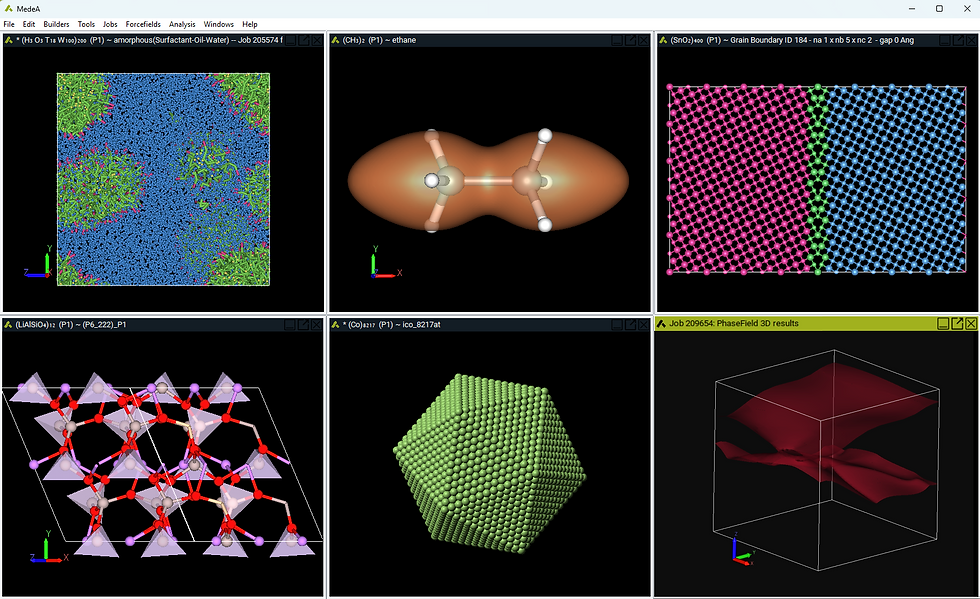New Publications!
- Katherine Hollingsworth
- May 15, 2019
- 3 min read
Read new publications created through the collaborative effort of Materials Design scientists and customers!
Title:
Analysis of Electronic and Structural Properties of Surfaces and Interfaces Based on LaAlO3 and SrTiO3
Abstract:
Recently, it was established that a two-dimensional electron system can arise at the interface between two oxide insulators LaAlO3 and SrTiO3. This par- adigmatic example exhibits metallic behaviors and magnetic properties between non-magnetic and insulating oxides. Despite a huge amount of theoretical and experi- mental work a thorough understanding is yet to be achieved. We analyzed the structural deformations of a LaAlO3 (001) slab induced by hydrogen adatoms and oxygen vacan- cies at its surface by means of density functional theory. Moreover, we investigated the influence of surface reconstruction on the density of states and determined the change of the local density of states at the Fermi level with increasing distance from the sur- face for bare LaAlO3 and for a conducting LaAlO3/SrTiO3 interface. In addition, the Al-atom displacements and distortions of the TiO6-octahedra were estimated.
Title:
Electronic properties of LaAlO3/SrTiO3 n-type interfaces: a GGA+U study
Abstract:
The role of electronic correlation effects for a realistic description of the electronic properties of heterostructures as covered by the on-site Coulomb repulsion within the GGA+U approach is investigated. Performing a systematic variation of the values of the Coulomb parameters applied to the Ti 3d and La 4f orbitals we put previous suggestions to include a large value for the La 4f states into perspective. Furthermore, our calculations provide deeper insight into the band gap landscape in the space spanned by these Coulomb parameters and the resulting complex interference effects. In addition, we identify important correlations between the local Coulomb interaction within the La 4f shell, the band gap, and the atomic displacements at the interface. In particular, these on-site Coulomb interactions influence buckling within the LaO interface layer, which via its strong coupling to the electrostatic potential in the LAO overlayer causes considerable shifts of the electronic states at the surface and eventually controls the band gap.
Title:
Oxygen vacancies and hydrogen doping in LaAlO3/SrTiO3 heterostructures: electronic properties and impact on surface and interface reconstruction
Abstract:
We investigate the effect of oxygen vacancies and hydrogen dopants at the surface and inside slabs of LaAlO3, SrTiO3, and LaAlO3/SrTiO3 heterostructures on the electronic properties by means of electronic structure calculations as based on density functional theory. Depending on the concentration, the presence of these defects in a LaAlO3 slab can suppress the surface conductivity. In contrast, in insulating SrTiO3 slabs already very small concentrations of oxygen vacancies or hydrogen dopant atoms induce a finite occupation of the conduction band. Surface defects in insulating LaAlO3/SrTiO3 heterostructure slabs with three LaAlO3 overlayers lead to the emergence of interface conductivity. Calculated defect formation energies reveal strong preference of hydrogen dopant atoms for surface sites for all structures and concentrations considered. Strong decrease of the defect formation energy of hydrogen adatoms with increasing thickness of the LaAlO3 overlayer and crossover from positive to negative values, taken together with the metallic conductivity induced by hydrogen adatoms, seamlessly explains the semiconductor-metal transition observed for these heterostructures as a function of the overlayer thickness. Moreover, we show that the potential drop and concomitant shift of (layer resolved) band edges is suppressed for the metallic configuration. Finally, magnetism with stable local moments, which form atomically thin magnetic layers at the interface, is generated by oxygen vacancies either at the surface or the interface, or by hydrogen atoms buried at the interface. In particular, oxygen vacancies in the TiO2 interface layer cause drastic downshift of the 3d eg states of the Ti atoms neighboring the vacancies, giving rise to strongly localized magnetic moments, which add to the two-dimensional background magnetization.
Title:
Magnetic Properties of LaAlO3/SrTiO3 Heterostructure Modelled on a Supercomputer
Abstract:
The oxide heterostructure composed of LaAlO3 (LAO) thin film on top of SrTiO3 (STO) substrate is the best known example of a system where a metallic state is formed in the STO layers next to the interface [1]. In the frame of present work we analyze an impact of oxygen vacancies and hydrogen dopants located in the AlO2 surface layer and in the TiO2 interfacial plane of LAO/STO heterostructure onto the magnetic properties by performing spin-polarized calculations based on density functional theory (DFT). We found stable local magnetic moments formed within atomically thin magnetic layers at the interface. We confirmed that magnetism can be generated by oxygen vacancies located either at the surface or at the interface. In addition, we demonstrate magnetic moments formation by hydrogen dopants located at the interface. Finally, the case of two defects combination was investigated, when negligibly small magnetic moment induction was found to take place.



Comments